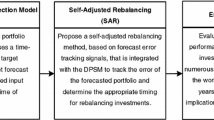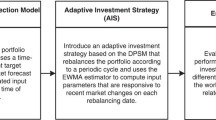Abstract
In this study, an intelligent forecasting models-selection system for refining portfolio structural estimation is proposed selecting different forecasts time series models, as well as the contents’ trend with refining the risk-return matrices of components. Based on the four inference rules in intelligent selection mechanism, the support system seeks to find the appropriate model solutions satisfying the tracking for the behavior of indices prices in portfolio optimization. The feasibility of the system is verified with a practical simulation experiment. The experimental results show that, for all examined investment assets, the presented system is an efficient way of solving the portfolio internal structure change problem. In addition, we also find that the presented system can also be used as an alternative method for evaluating various forecasting models. By means of global major market as the empirical evidences of portfolio contents, it will show that the proposed system can serve as improving efficient frontier of a portfolio.
Similar content being viewed by others
References
Akaike H (1974) A new look at the statistical model identification. IEEE Trans Automatic Control 19:716–723
Burnham KP, Anderson DR (1998) Model selection and inference. Springer, Heidelberg
Box GP, Jenkins GM (1976) Time series analysis: forecasting and control, Revised edition. Holden-Day, San Francisco
Cochrane D, Orcutt GH (1949) Application of least squares regression to relationships containing autocorrelated error terms. J Am Stat Assoc 44:32–61
Dempster MAH, Jones CM (2001) A real-time adaptive trading system using genetic programming. Quant Fin 1:397–413
Dose C, Cincotti S (2005) Clustering of financial time series with application to index and enhanced index tracking portfolio. Physica A 355:145–151
Gardner ES (1985) Exponential smoothing: the state of the art. J Forecast 4(1):1–38
Holt CC (1957) Forecasting trends and seasonal by exponentially weighted moving averages. O.N.R. Memorandum. Carnegie Institute of Technology, 52
Koehler AB, Murphree ES (1986) A comparison of the AIC and BIC on empirical data. 6th international symposium on forecasting, Paris
Ljung GM, Box GP (1978) On a measure of lack of fit in time series models. Biometrika 65:297–303
Markowitz HM (1952) Portfolio selection. J Fin 7:77–91
Markowitz HM, Usmen N (2003) Resampled frontiers versus diffuse bayes: an experiment. J Invest Manage 1(4):1–4
Michaud RO (1998) Efficient asset management: a practical guide to stock portfolio optimization and asset allocation. Harvard Business School Press, Massachusetts
Michaud RO (2002) An introduction to resampled efficiency, New Frontier Advisors. Boston, MA 02110, USA
Michaud RO (2004) Why Mean-Variance Optimization Isn’t Useful for Investment Management. New Frontier Advisors
Neely CJ, Weller PA, Dittmar R (1997) Is technical analysis in the foreign exchange market profitable? A genetic programming approach. J Financ Quant Anal 32(4):405–426
Robert L, Goodrish L, Stellwagen EA (2000) Applied statistical forecasting. BFS, Inc. 21030, Zuni Road Apple Valley, CA 92307, USA
Schwarz G (1978) Estimating the dimension of a model. Ann Stat 6:461–464
Yu L, Wang S, Lai KK (2007) Neural network-based mean-variance-skewness model for portfolio selection. Comput Oper Res (in press)
Author information
Authors and Affiliations
Corresponding author
Rights and permissions
About this article
Cite this article
Wang, HW. Intelligent forecasting models-selection system for the portfolio internal structure change. Soft Comput 11, 1141–1147 (2007). https://doi.org/10.1007/s00500-007-0177-8
Published:
Issue Date:
DOI: https://doi.org/10.1007/s00500-007-0177-8




